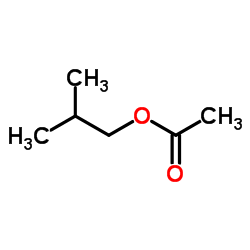Isobutyl acetate

Isobutyl acetate structure
|
Common Name | Isobutyl acetate | ||
|---|---|---|---|---|
| CAS Number | 110-19-0 | Molecular Weight | 116.158 | |
| Density | 0.9±0.1 g/cm3 | Boiling Point | 116.6±0.0 °C at 760 mmHg | |
| Molecular Formula | C6H12O2 | Melting Point | -99 °C | |
| MSDS | Chinese USA | Flash Point | 21.7±0.0 °C | |
| Symbol |


GHS02, GHS07 |
Signal Word | Danger | |
|
Combined effects of nutrients and temperature on the production of fermentative aromas by Saccharomyces cerevisiae during wine fermentation.
Appl. Microbiol. Biotechnol. 99(5) , 2291-304, (2015) Volatile compounds produced by yeast during fermentation greatly influence the organoleptic qualities of wine. We developed a model to predict the combined effects of initial nitrogen and phytosterol content and fermentation temperature on the production of v... |
|
|
How do esters and dimethyl sulphide concentrations affect fruity aroma perception of red wine? Demonstration by dynamic sensory profile evaluation.
Food Chem. 194 , 196-200, (2015) Our study focused on variations in wine aroma perception and molecular composition during tasting over a period of 30min. In parallel, dynamic analytical and sensory methods were applied to study changes in the wines' molecular and aromatic evolution. Dynamic... |
|
|
Differentiation of South American crack and domestic (US) crack cocaine via headspace-gas chromatography/mass spectrometry.
Drug Test. Anal. 7(3) , 241-6, (2015) South American 'crack' cocaine, produced directly from coca leaf, can be distinguished from US domestically produced crack on the basis of occluded solvent profiles. In addition, analysis of domestically produced crack indicates the solvents that were used fo... |
|
|
Volatile Compounds from Grape Skin, Juice and Wine from Five Interspecific Hybrid Grape Cultivars Grown in Québec (Canada) for Wine Production.
Molecules 20 , 10980-1016, (2015) Developed from crosses between Vitis vinifera and North American Vitis species, interspecific hybrid grape varieties are becoming economically significant in northern areas, where they are now extensively grown for wine production. However, the varietal diffe... |
|
|
Approaches of aroma extraction dilution analysis (AEDA) for headspace solid phase microextraction and gas chromatography-olfactometry (HS-SPME-GC-O): Altering sample amount, diluting the sample or adjusting split ratio?
Food Chem. 187 , 44-52, (2015) Aroma extract dilution analysis (AEDA) is widely used for the screening of aroma-active compounds in gas chromatography-olfactometry (GC-O). In this study, three aroma dilution methods, (I) using different test sample volumes, (II) diluting samples, and (III)... |
|
|
Increase of fruity aroma during mixed T. delbrueckii/S. cerevisiae wine fermentation is linked to specific esters enhancement.
Int. J. Food Microbiol. 207 , 40-8, (2015) The aim of this work was to study ester formation and the aromatic impact of Torulaspora delbrueckii when used in association with Saccharomyces cerevisiae during the alcoholic fermentation of must. In order to evaluate the influence of the inoculation proced... |
|
|
Serum proteins of rats exposed to organic solvents examined by horizontal two-dimensional electrophoresis with an immobilized pH gradient in the first dimension.
Electrophoresis 11(8) , 655-7, (1990) Serum proteins of rats, exposed to methoxyethylacetate and a combination of methoxyethylacetate and isobutylacetate, were analyzed by horizontal high resolution two-dimensional gel electrophoresis with immobilized pH gradients in the first dimension. A total ... |
|
|
A comparison of laboratory and pilot-scale fermentations in winemaking conditions.
Appl. Microbiol. Biotechnol. 87(5) , 1665-73, (2010) We investigated the influence of the fermenter size on alcoholic fermentation. Experiments were carried out at pilot scale, in 100-L fermenters, and at laboratory scale, in stirred and static 1-L fermenters. Two musts, Grenache blanc and Sauvignon, were ferme... |
|
|
Nasal symptoms and histopathology in a group of spray-painters.
Acta Otolaryngol. 96(5-6) , 495-500, (1983) Industrial workers more and more frequently seek medical advice for nasal and sinus symptoms that they attribute to occupational exposure. The present study comprised 10 paint-sprayers exposed to solvents (primarily toluene and isobutylacetate) and dust. The ... |
|
|
Vapor-phase analysis of isobutyl acetate, isopropyl acetate, n-propyl acetate and their respective alcohols using solid-phase microextraction-gas chromatography with a mass selective detector.
J. Chromatogr. A. 1066(1-2) , 225-30, (2005) A solid-phase microextraction (SPME)-GC-MS method for three esters and the corresponding alcohols was tested for responses in accuracy, within-run precision (repeatability), and between-run precision (reproducibility) due to individual operators, individual a... |